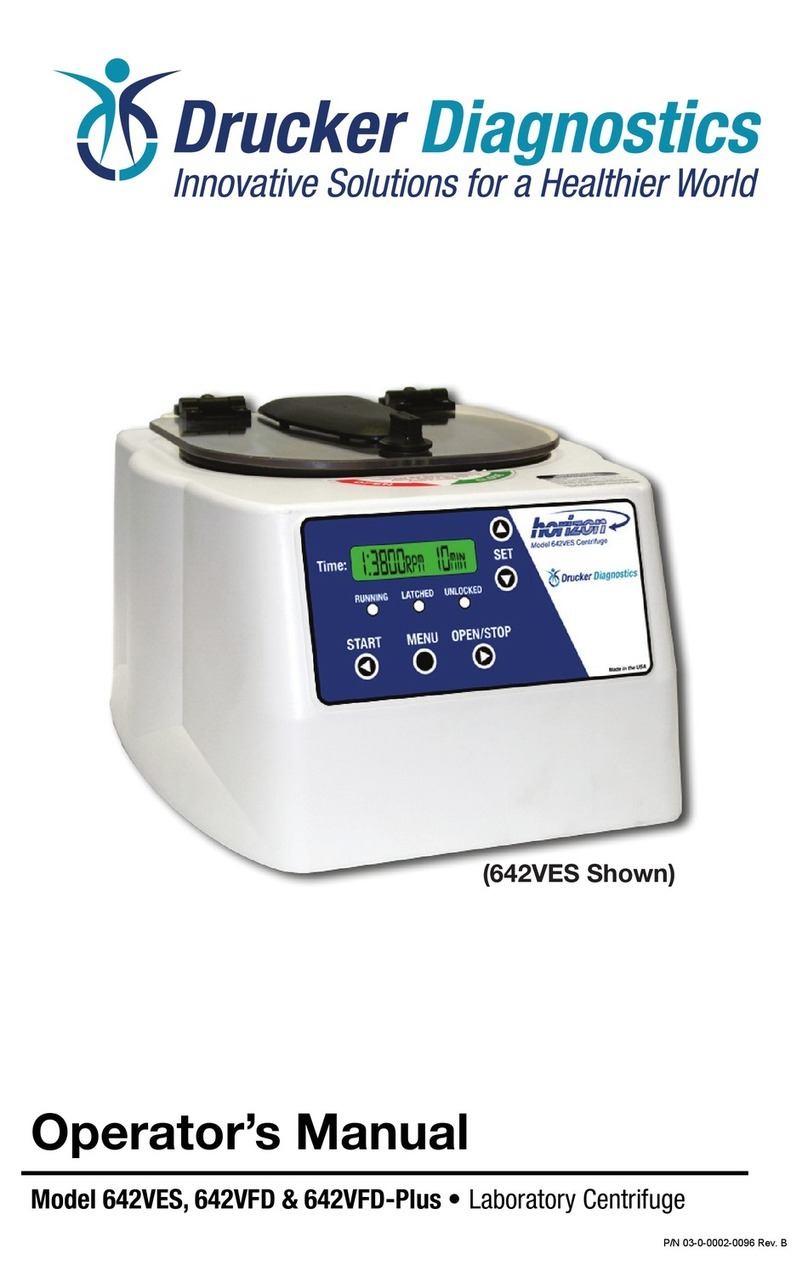Page 2
Model Description:
The Model 642E is a continuous-duty, electronically-controlled horizontal
centrifuge with a lid safety interlock system. The unit is controlled by an
electronic push–button timer that has been preset for ten (10) minutes, for
precise spin times and ease of use. Samples can be safely viewed through
the transparent lid. Entry into the machine is restricted during operation by the
safety interlock system. The Model 642E features a lighted control panel that
displays the status of the machine, easily viewable from a distance.
For warranty information, turn to page 12.
Intended Use:
General purpose laboratory centrifuge for sample separation.
Supplied Equipment*:
The following items come standard with each Model 642E centrifuge:
1. One (1) six–place horizontal rotor
2. Six (6) 100 mm tube holders
3. Six (6) 75 mm tube holders
4. Two (2) 13 x 75 mm inserts p/n 7713064 (Not shown below)
5. Two (2) 13 x 100 mm inserts p/n 7713066 (Not shown below)
6. Two (2) 0.5 to 1 mL tube adapters p/n 7713068 (Not shown below)
7. Two (2) 1.5 to 2 mL tube adapters p/n 7713065 (Not shown below)
WARNING: For the safety of both the opera-
tor and service personnel, care should be
taken when using this centrifuge if handling
substances that are known to be toxic,
radioactive or contaminated with pathogenic
microorganisms. When Risk Group II ma-
terials are used, (as identied in the World
Health Organization “Laboratory Bio-Safety
Manual”), a Bio-Seal should be employed.
The Bio-Seal accessory for the model 642
tube holders is the non-aerosol shield cap,
p/n 7713011. In the event that materials of a
higher risk group are being used, more than
one level of protection must be provided.
The use of ammable or explosive materials
as well as those materials which have a
vigorous chemical reaction is prohibited.
For your safety and the durability of your
machine, never transport or store centrifuge
with tube holders inside machine.
Table of Contents
Model Description ............................... pg. 2
Intended Use....................................... pg. 2
Supplied Equipment ............................ pg. 2
Features .............................................. pg. 3
Specications ...................................... pg. 3
Setup Location .................................... pg. 3
Initial Setup Procedure........................ pg. 4
Front Panel Controls ........................... pg. 5
Operation ............................................ pg. 6
Tube Holder Congurations ................ pg. 7
Rotor Removal and Installation ........... pg. 8
Care and Maintenance........................ pg. 8
Cleaning and Disinfection ................... pg. 9
Troubleshooting................................... pg. 10
Safety .................................................. pg. 11
Emergency Rotor Chamber Entry ....... pg. 11
Calibration and Ground Testing........... pg. 11
Replacement Parts.............................. pg. 12
Available Accessories ......................... pg. 12
p/n 7786061
p/n 7713031
p/n 7713033
Page 11
1. 2.
x6
* The rotor and rotor accessories are rated for a rotation frequency of 4,000 RPM.
3.
x6
Safety:
Lid Safety Switch: The Model 642E lid is secured to the top of the cabinet by
a latching knob and pawl system. When the knob is rotated clockwise, the pawl
grips the underside of the cabinet opening and prevents the lid from opening.
A mechanical stop positions the pawl and prevents it from rotating completely.
When rotated to the stop position, the pawl makes contact with a micro–switch
mounted underneath the cabinet top. The lid safety switch prevents the centri-
fuge from operating while the lid is open. An indicator light on the front of the
machine will light up when the lid has been latched properly.
Lid Safety Interlock System: In addition to the Lid Safety Switch, the Model
642E has a true “0 RPM” lid locking system. The lid safety interlock system
keeps the lid locked at all times, (even during power failure), and requires that
the rotor be at rest in order to unlock the lid. The centrifuge will not allow entry
into the rotor chamber unless the centrifuge has power and the rotor is stopped.
To open the lid, make sure that the centrifuge is plugged in and, with the rotor
stopped, press the ‘OPEN / STOP’ button.
Note: After the centrifuge has started spinning, it may be possible to rotate
the lid knob enough to cause the pawl to lose contact with the lid safety
switch. If this happens, the centrifuge motor may lose power, but the lid
will still remain locked. If the knob is accidentally moved and this situation
should occur, rotate the knob fully clockwise to its stop position and the
centrifuge will resume operation.
Circuit Breaker: The Model 642E is protected with a 4 Amp circuit breaker lo-
cated at the rear of the machine mounted to the base. Any electrical short circuit
will cause the breaker to cut power to the machine.
Emergency Rotor Chamber Entry:
In the event of power failure, it may be impossible to unlock the lid by
conventional means. In this case, entry into the rotor
chamber may be made by removing the latch label
and using a pen to manually disengage the locking
mechanism (see photo). Pull the mechanism towards
the control panel and then unlatch and open the lid.
If the unit is damaged, contact your authorized dealer
or Drucker Diagnostics.
Calibration and Earth Ground Testing:
It is recommended that the top speed, ground continuity and line leakage
be tested every two years for continued safe operation. Contact Drucker
Diagnostics for further information or testing availability.
For Optional Accessories see the last page of this manual


























